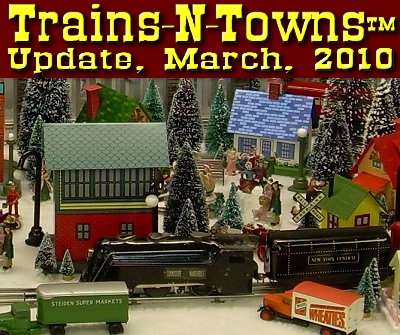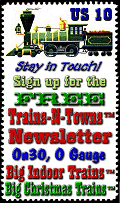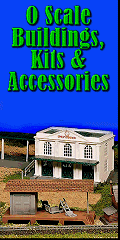 | |||
 |
 |  |
 |  |
 |  | ||
 |  | ||
 |  | ||
 | |||
 |
 |  |
 |  |
 |  | ||
 |  | ||
 |  | ||

| Written by Paul D. Race for Big Indoor TrainsTM and Big Christmas TrainsTM |



|
Trains-N-TownsTM, the Official Newsletter of BIGIndoorTrains.com and BIGChristmasTrains.comThis newsletter is for people who like O scale, O gauge, S scale, and Christmas trains, including people who combine On30 or O gauge trains with collectible villages. It is produced in conjunction with the Big Indoor TrainsTM and Big Christmas Trains web sites.
In this IssueEvery year I promise myself that this will be the year in which I put out twelve monthly newsletters, all on time. But this obviously isn't the year. We've been reminded again that life can go sideways in a hurry, such as when your company goes south (literally - from Ohio to Georgia). (Since some of you have asked, in the "full-sized world" I'm a senior technical writer and part-time English professor.) Better yet, your own job crosses the Pacific, and you're asked to keep up a full load of work while spending your last eight weeks on the job teaching a third-world trainee everything it took you thirty years and two college degrees to learn. And that is not the most surrealistic thing that's happened to us - it's just the one that's easiest to put into writing. Suffice to say that if events in your life have pegged the "strange-o-meter" OR the "stress-o-meter" this winter, we have some idea of how you feel. And if the last thing you want to hear about right now is trains, we understand, and we hope to continue to offer our friendship and best wishes.On the bright side, there's lots of good news about the hobby. For example, Lionel has replaced the 4-4-2 in most of their starter sets with an 0-8-0, giving you a way to buy another starter set without getting a duplicate locomotive. And Bachmann is continuing to introduce new On30 projects. As for us, we've been getting so many new sign-ups that it's hard to keep up. Also, being housebound a few extra days did give me the opportunity to make headway on a project we started without much fanfare about a year ago - a tribute to the greatest classic railroad songs. As a train lover, amateur historian, and sometime folk singer, I wasn't surprised that the stories behind songs like "Casey Jones" and "City of New Orleans" are as fascinating as the songs are "catchy." But after auditioning hundreds of recordings, I was surprised to learn that, as often as not, the versions I learned from my big sister's folk albums while I was growing up were, frankly, bland and inauthentic compared to earlier AND later recordings. In several cases, the most heartfelt, respectful, and authentic presentation of the songs was actually from two fellows I wouldn't ordinarily consider "folksingers" or "song historians" at all - Johnny Cash and Willie Nelson. Those artists have always had their own styles, of course, but they have always RESPECTED the song, and that's important. Of course you may prefer another artist, and there are many great recordings to choose from. Unfortunately I don't have the bandwith or income to make the best recordings of the songs available for free. (I haven't profiled all of the songs I want to yet, either.) But in most cases, I've been able to find You-Tube videos that give you the chance to hear the whole song, as well as a selection of Amazon "clips" to choose from if you want to put together your own CD of "all-star" train song performances. Now let's talk about trains: Every so often, someone asks me why their locomotive runs "jerky," and I tell them they need to clean their track and at least the power pickup wheels on their trains. I usually remind them that most gunk on track and train wheels comes from plastic wheels - if you replace your trains' wheels with metal, they'll need much less maintenance. But that said, getting access to power pickup wheels to clean them thoroughly isn't always easy, so we've put together an article showing some concerns and different approaches. We also have another article in our ongoing "Tribute to TinplateTM" series. Based on the 1 1/2-story houses that became popular in Ohio in the mid-1900s, and commemorated by a 1950s Bachmann Plasticville structure, the Cape Code makes an easy, attractive, and inexpensive addition to the vintage-style neighborhoods we've already provided instructions for. Several more articles are in the works, but if we wait until they're all ready, it would be August before we get this newsletter out. So stay tuned. Finally, please accept our warm wishes for a great spring season (or autumn, for those of you who live "Down Under"). And please especially enjoy any time you can spend with your family in the coming days - Topics discussed in this update include:
An easy, but charming "Tribute To Tinplate" structure that looks great with our other projects but will stand fine on its own as well. Paul's graphics commemorate the lithographed art of century-old tinplate structures originally made to go with Lionel and Ives trains. Howard Lamey's construction tips will give you a first-class finished structure, all for only a few cents worth of cardboard, paper, and glue. Includes free plans, graphics, and instructions. Click the following link for more information.
|


|

|

|  |
 |
 |  |  |
Note: Big Indoor TrainsTM, Trains-N-TownsTM, Big Train StoreTM Family Garden TrainsTM, Big Christmas TrainsTM, Garden Train StoreTM, and Tribute to TinplateTM are trademarks of Breakthrough CommunicationsTM (www.btcomm.com). All information, data, text, and illustrations on this web site are Copyright (c) 1999, 2000, 2001, 2002, 2003, 2004, 2005, 2006, 2007, 2008, 2009, 2010 by Paul D. Race.
Reuse or republication without prior written permission is specifically
forbidden.
Big Indoor Trains(tm) is a participant in the Amazon Services LLC Associates Program, an affiliate advertising program designed to provide a means for sites to earn advertising fees by advertising and linking to amazon.com.
For more information, contact us.
